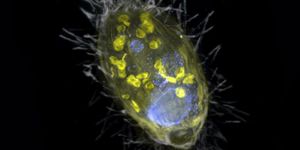Before the Cambrian explosion, also known s the biological Big Bang, there were only primitive life forms in Earth's oceans. There was a massive proliferation of life during this period, which occurred about 570 to 530 million years ago. Most major animals lineages got their start during this time, and have been evolving ever since. Scientists have now determined that the genes responsible for learning, memory, and other complex behaviors including aggression originated even before this, about 650 million years ago. The findings have been reported in Nature Communications.

Neurotransmitters are are crucial for sending essential messages in the nervous system. They include monoamine chemicals like dopamine, serotonin, and adrenaline/noradrenaline (also known as epinephrine/norepinephrine), which are involved in basic processes like eating and sleeping, as well as learning and forming memories.
This study has suggested that the genes that are required for generating, binding, and responding to monoamines originated in bilatarians, organisms that have left-right symmetry, and that these genes may have played a role in how animals diversified during the Cambrian Explosion. These genes might have provided flexibility to neuronal circuits that helped animals interact with their environments.
With computational methods, the researchers reconstructed the evolution of genes that were required for monoamine production, degradation, reception, and use. They trace back to the bilatarian stem group. "This finding has profound implications on the evolutionary origin of complex behaviors such as those modulated by monoamines we observe in humans and other animals," said corresponding study author Dr. Roberto Feuda of the University of Leicester.
"This discovery will open new important research avenues that will clarify the origin of complex behaviors and if the same neurons modulate reward, addiction, aggression, feeding, and sleep."
The study authors acknowledged that monoamines can also be found in non-bilatarian metazoans, and proposed that enzymes could be responsible for generating those molecules in such animals. For example, in Drosophila melanogaster and Caenorhabditis elegans, aromatic amino acid orthologs produce serotonin.
Sources: University of Leicester, Nature Communications



